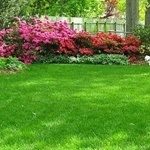Lawn Treatment Program
LIBERTY’S LAWN CARE PROGRAM

The key to implementing a successful lawn care program is consistency. It all starts with a lawn inspection. We’ll analyze the growing environment, current condition and any emerging issues. Then, design your Program to provide the care and treatments needed for a healthy, green lawn.
Your Liberty Lawn Specialist will go over the results of his evaluation with you. He will provide his professional recommendations for exactly what your lawn needs to be as successful as possible.
Our skilled lawn technicians go the extra mile. By signing up for one of our Lawn Care Programs, you can enjoy outdoor living with a lawn that’s healthy, green and beautiful.
DO YOU WANT A BEAUTIFUL, HEALTHY, GREEN LAWN?
CHOOSE TRADITIONAL OR 100% ORGANIC LAWN CARE PROGRAM
Liberty customizes your lawn treatment program to meet the exact needs of your lawn and achieve your goals. That’s why Liberty offers two lawn program options. You can choose either a traditional 6 Visit Lawn Care Program or our 100% Organic 7 Step Program.
6 VISIT LAWN CARE PROGRAM
Our SIX VISIT Annual Lawn Treatment Program will give your lawn everything it needs to enhance the soil as well as provide nutrients through the spring, summer and fall growing seasons. In addition to building a beautiful, green lawn, our lawn treatments will help make your lawn more resistent to stress, diseases and insects.
Your Liberty PA Certified Lawn Technician monitors your lawn on regular visits. During his visit, he will check lawn health and apply a specially blended fertilizer treatment. If weeds appear, he will apply weed control only as needed. This eliminates unnecessary use of chemicals.
ORGANIC / NATURAL LAWN PROGRAM
Our Organic / Natural Lawn Care Program gives you the homeowner an option. Our trained technicians will implement our complete 7 step program using a full line of OMRI approved, EPA exempt, Organic / Natural products to manage your turf, giving you the peace of mind knowing no chemicals are being used on your property.
Schedule Your Free Evaluation!
Call : 215.309.8700 or Contact Us!
Plant Health Care
TREE SERVICES
MOSQUITO
& TICK
PROTECTION
HARDSCAPING
LANDSCAPING
LAWN CARE
